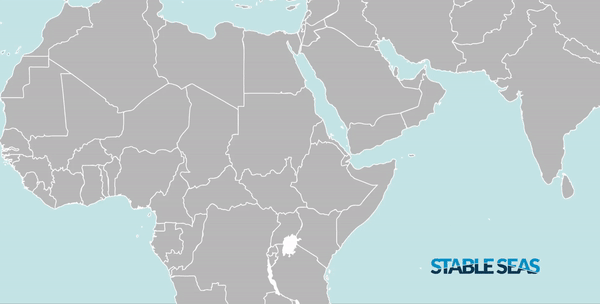
We know a lot about the migration routes of the thousands who die at sea trying to get to Europe. But what about the plight of Africans migrating throughout Africa, often in unmonitored waters? In this third post in a series on migration issues at land and sea, we examine the risks and factors of migration routes in four regions in sub-Saharan Africa.
This is the third post in a series on migration issues on land and sea.
By Emina Sadic
We know a lot about the migration routes of the thousands who die at sea trying to get to Europe. But what about the plight of Africans migrating throughout Africa? Because their migration routes often take place in unmonitored waters, we know much less. During the research for our Stable Seas project, we set out to learn about maritime migration and identified four regions with existing maritime routes throughout sub-Saharan Africa. Each route is unique in terms of volume of people moving, risks and vulnerabilities, and changes due to external factors such as conflict or maritime patrols.
What maritime routes are people taking to leave sub-Saharan Africa?
In West Africa, migrants were traveling to the Canary Islands in hopes of landing eventually in Spain. However, in 2006 this route was largely cut off through interception of migrant vessels by Spanish and regional navies. The security measures were effective in decreasing the number of migrants attempting this specific route, but in turn, migrants chose the dangerous route of least resistance through the Sahel and Sahara leading to North Africa and eventually Europe by boat. In the past two years, however, arrivals in Spain from North Africa, also known as the Western Mediterranean Route, have picked up again.
Another route leads people from the Horn of Africa to Yemen and eventually the Gulf States. Since the outbreak of the conflict in Yemen in 2015, fewer people have chosen this specific route, and in fact we’ve seen a reverse flow of people from Yemen to the Somali coast. More recently, small numbers have been observed to leave Bosasso in the Somali region to travel to Sudan via Yemen, eventually joining the different branches of the Central Mediterranean Route to European shores via Libya.
What maritime routes exist within sub-Saharan Africa?
The focus on routes to Europe and the Gulf have distracted us from the fact that many people travel south. Rich in oil, Equatorial Guinea and Gabon, for example, attract many people from West Africa who transit through the major hub of Calabar in Nigeria in the hope of finding employment.
On the other side of the continent, some Ethiopians and Somalis travel to South Africa, by both land and sea. Depending on the security situation or information shared by migrants along the coast, migrants on this southern route often travel by sea to Mozambique, circumventing Kenya and Tanznaia. Once in Mozambique, the journey to South Africa continues on land.
There is one maritime-based migration route that certainly has not received much attention until recently—the route from Comoros to Mayotte. A French territory in the Mozambique Channel, Mayotte attracts people from the Comoros and to a lesser extent Madagascar due to higher wages, better access to education and health care, and prospects of acquiring French citizenship through birthrights. The exact number of migrants attempting this journey is unknown, although sea-related deaths indicate it is in the tens of thousands.
How dangerous are these routes?
African migrants run the risk of mistreatment, including extortion and labor or sex trafficking, by smugglers and/or traffickers. They also face the risk of drowning when overcrowded and unseaworthy boats capsize. Similarly, smugglers have forced migrants off vessels before reaching shore in order to avoid detection by coastal authorities, leading to the deaths of migrants unable to swim.
The exact number of African migrants who die at sea in African waters is not known. In the Mayotte context, estimates range between 7,000 and 10,000 to as high as 50,000 since 1995, when visa-free travel between islands was halted.
But the risks for migrants are not just at sea. Leaving from or transiting through conflict-affected countries increases their vulnerabilities exponentially. Among the risks, kidnapping for ransom and extortion has been reported for migrants on the Central Mediterranean Route and those who travel across the Horn of Africa. Equally prevalent are trafficking for forced labor and sexual exploitation, especially in areas with weak governance and absence of protection measures. Women and children are particularly vulnerable to sex trafficking and abuse.
What needs to be done?
First, we need to understand that maritime-based routes in sub-Saharan Africa will continue to be utilized so long as incidents on land fuel voluntary and involuntary migration. The emphasis on securitizing the seas, without addressing the root causes of migration, often detrimentally affects migrants as the case of West Africa has demonstrated. While the European Union pledged $1.9 billion to “address the root causes of migration,” effective monitoring regimes are also essential to trace the extent to which sub-Saharan maritime routes are in use. Knowing the extent of the problem will help states and regional organizations to implement protective measures to prevent the exploitation and death of migrants on land and at sea. As with other maritime-related challenges, collaboration and coordination are key to ensure not only that migrants at sea are protected but also that we understand that deterrence strategies have done little to change people’s determination to migrate.
---
This blog post is part of a series on maritime mixed migration. Check back next week for the next installment.
The United Nations’ Sustainable Development Goals (or SDGs) present an ambitious opportunity to address global issues of poverty, violence, and environmental degradation. Recognizing the interrelated challenges posed by inequality, instability, and ecological threats, the SDGs provide 17 areas the international community has committed to addressing in order to foster greater global stability. Key to addressing many of these issues (such as peace and economic development) is tackling the many challenges posed when people feel compelled to leave their homes due to poverty or conflict, among other reasons. Migration—both regular and irregular— takes many forms, such as climate- or conflict-induced displacement, economic migration, asylum-seeking, forced labor, smuggling, or human trafficking.
Article Details
Published
Topic
Program
Content Type
Opinion & Insights
